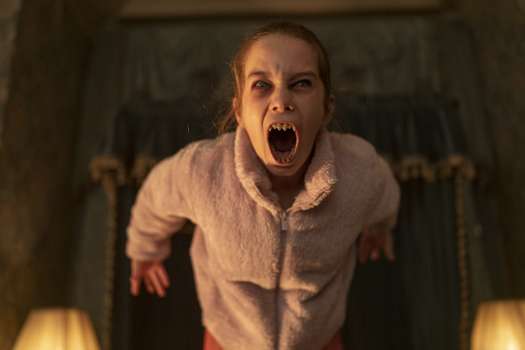The 25th day of April, Anzac Day, marks the anniversary of the initial campaign that led to major casualties for New Zealand and Australian armed forces during the First World War. Though recognized by other dominions of the British Commonwealth involved in the 1915 Gallipoli campaign, it's an occasion of specific significance in New Zealand and Australia, as it's tied to their respective sovereign identities.
Documentarian Leanne Pooley (The Topp Twins: Untouchable Girls) — a Canadian expat living in New Zealand — has crafted a particularly visionary work with her experimental, animated film 25 April. It's still very much a documentary, providing detailed historical context and information pertaining to the Gallipoli campaign, but it employs innovative visuals and creative stylization to capture the intensity and raw emotion of the archived letters and anecdotes presented from the time. As the authors of this intimate correspondence are long-deceased, these animations — based on photographs of those involved in the campaigns — help bring an authenticity and urgency to this historical dialogue that re-creations or a "talking head" dynamic might inadvertently have subdued.
Before launching into things, some context is given about the origins of the campaign. Pooley outlines that the effort to secure the peninsula surrounding the Dardanelles Strait, which allowed sea transport to the Russian Empire, was a strategic manoeuvre intended to knock the Ottoman Empire out of the war that ultimately failed. The launch ultimately became a stalemate, resulting in thousands of deaths, dragging on for nearly a year before forces were evacuated. What she then goes on to document, through faux-interviews and intricate drawings, is the status quo of those eight months and what it was like for those soldiers to live in subhuman conditions.
Though this time in history was tragic, what works about 25 April is its ability to capture the humanity and the oft-overlooked incidental aspects of the situation, keeping the tone from getting too bogged down in self-importance or severity. Anecdotes are shared about skinny-dipping and games the soldiers might play to pass the time, adding a bit of humour and humanity to the film. Of course, there are also acknowledgements of other problems, such as the lice epidemic and the disease that plagued the soldiers, which nearly drove them to insanity.
Since this polished work is presented as a story with a tapestry of different characters, be them soldiers or nurses, there's a natural investment in storylines and characters. Pooley's style works as a narrative film despite being a documentary, having a momentum to it that injects the arcs and themes that typically distinguish the two methods of filmmaking. What this ultimately does is give an identifiable face to what is now mostly understood as a pointless exercise in human carnage and suffering.
There are themes of futility floating throughout, just as the limited capacity of the human spirit is used as a mode of social analysis, but the individual people telling their specific stories, acknowledging the seemingly incidental amidst the larger-than-life, is what gives 25 April its power. And, though some of the computer animation is a tad rudimentary in some of the more realist action scenes — the abstract slow motion and exaggerated colour works extremely well in the non-realist, impressionist battle scenes, however — there is something quite moving about remembering what makes us unique individuals in times of mass dehumanization and degradation that stands out here.
(General Film)Documentarian Leanne Pooley (The Topp Twins: Untouchable Girls) — a Canadian expat living in New Zealand — has crafted a particularly visionary work with her experimental, animated film 25 April. It's still very much a documentary, providing detailed historical context and information pertaining to the Gallipoli campaign, but it employs innovative visuals and creative stylization to capture the intensity and raw emotion of the archived letters and anecdotes presented from the time. As the authors of this intimate correspondence are long-deceased, these animations — based on photographs of those involved in the campaigns — help bring an authenticity and urgency to this historical dialogue that re-creations or a "talking head" dynamic might inadvertently have subdued.
Before launching into things, some context is given about the origins of the campaign. Pooley outlines that the effort to secure the peninsula surrounding the Dardanelles Strait, which allowed sea transport to the Russian Empire, was a strategic manoeuvre intended to knock the Ottoman Empire out of the war that ultimately failed. The launch ultimately became a stalemate, resulting in thousands of deaths, dragging on for nearly a year before forces were evacuated. What she then goes on to document, through faux-interviews and intricate drawings, is the status quo of those eight months and what it was like for those soldiers to live in subhuman conditions.
Though this time in history was tragic, what works about 25 April is its ability to capture the humanity and the oft-overlooked incidental aspects of the situation, keeping the tone from getting too bogged down in self-importance or severity. Anecdotes are shared about skinny-dipping and games the soldiers might play to pass the time, adding a bit of humour and humanity to the film. Of course, there are also acknowledgements of other problems, such as the lice epidemic and the disease that plagued the soldiers, which nearly drove them to insanity.
Since this polished work is presented as a story with a tapestry of different characters, be them soldiers or nurses, there's a natural investment in storylines and characters. Pooley's style works as a narrative film despite being a documentary, having a momentum to it that injects the arcs and themes that typically distinguish the two methods of filmmaking. What this ultimately does is give an identifiable face to what is now mostly understood as a pointless exercise in human carnage and suffering.
There are themes of futility floating throughout, just as the limited capacity of the human spirit is used as a mode of social analysis, but the individual people telling their specific stories, acknowledging the seemingly incidental amidst the larger-than-life, is what gives 25 April its power. And, though some of the computer animation is a tad rudimentary in some of the more realist action scenes — the abstract slow motion and exaggerated colour works extremely well in the non-realist, impressionist battle scenes, however — there is something quite moving about remembering what makes us unique individuals in times of mass dehumanization and degradation that stands out here.




